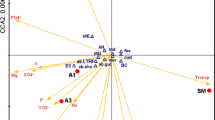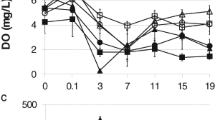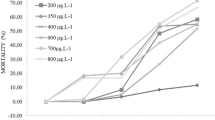Abstract
Effects of the widely employed insecticide Lorsban®48E formulation of chlorpyrifos (CPF) was studied on Rhinella fernandezae tadpoles, a native species of Argentina, Brazil, Paraguay and Uruguay, under the hypothesis of a differential response of organisms from ponds of two sites with different degree of anthropogenic disturbance: S1 an unpolluted area, and S2 area with high degree of antropogenic disturbance. To collect a representative sample of the genotypic variability of each population, small portions from six clutches were taken randomly from each site when the period of clutching was finished. Embryos and tadpoles were maintained under controlled laboratory conditions. Toxicity tests were conducted under standardized conditions to study acute and chronic lethal (mortality) and sublethal effects (behavior, growth, and abnormalities), within the range of concentrations of 0.010 to 5 mg/L. Chronic effects were assessed with organisms from one of the demes (S1). CPF showed high toxicity on the tadpoles, inducing lethal and sublethal effects at 96 h exposure within a narrow range of concentrations from 0.066 to 0.887 mg/L. Results indicate that R. fernandezae tadpoles are below the 30th percentile in the species sensitivity distribution of existing data. The acute LC50, NOEC, and LOEC values were 0.151, 0.066, and 0.133 mg/L for S1, and 0.293, 0.177, and 0.266 mg/L for S2, respectively. Considering all acute end-points evaluated, the effects of CPF showed no significant differences (p = 0.3484) between the studied populations. CPF has more severe effects at higher concentrations than at higher times of exposure. Contaminants in S2 do not seem to induce local adaptation. Sublethal effects data and measured environmental concentrations indicate potential risk for populations inhabiting agroecosystems.


Similar content being viewed by others
References
Abbasi SA, Soni R (1991) Evaluation of water quality criteria for four common pesticides on the basis of computer-aided studies. Indian J Environ Health 33(1):22–24
Agostini MG, Natale GS, Ronco AE (2010) Lethal and sublethal effects of cypermethrin to Hypsiboas pulchellus tadpoles. Ecotoxicology 19(8):1545–1550
Allran JW, Karasov WH (2001) Effects of atrazine on embryos, larvae, and adults of anuran amphibians. Environ Toxicol Chem 20(4):769–775
Altig R, McDiarmid RW (1999) Body plan. In: McDiarmid RW, Altig R (eds) Tadpoles: the biology of anuran larvae, 1st edn. University of Chicago Press, Chicago, pp 24–51
Bantle JA, Dumont JN, Finch RA, Linder G, Fort DJ (1996) Atlas of abnormalities. A guide for the performance of FETAX, 2nd edn. Oklahoma State University, Stillwater
Barron MG, Woodburn KB (1995) Ecotoxicology of chlorpyrifos. Rev Environ Contam Toxicol 144:1–93
Beebee TJC, Griffiths RA (2005) The amphibian decline crisis: a watershed for conservation biology. Biol Conserv 125:271–285
Berrill M, Bertrama S, Wilson A, Louis S, Brighaman D, Stromberg C (1993) Lethal and sublethal impacts of pyrethroid insecticides on amphibian embryos and tadpoles. Environ Toxicol Chem 12:525–539
Blaunstein AR, Kiesecker JM (2002) Complexity in conservation: lessons from the global decline of amphibian populations. Ecol Lett 5:597–608
Bleyl DW (1980) Embryotoxicity and teratogenicity of phosmet in mice. Arch Exp Veterinarmed 34:791–795
Bonfanti P, Colombo A, Orsi F, Nizzetto I, Andrioletti M, Bacchetta R, Mantecca P, Fascio U, Vailati G, Vismara C (2004) Comparative teratogenicity of chlorpyrifos and malathion on Xenopus laevis development. Aquat Toxicol 70:189–200
Bridges CM (1997) Tadpole swimming performance and activity affected by acute exposure to sublethal levels of carbaryl. Environ Toxicol Chem 16(9):1935–1939
Brunelli E, Bernabo I, Berg C, Lundstedt-Enkel K, Bonacci A, Tripepi S (2009) Environmentally relevant concentrations of endosulfan impair development, metamorphosis and behaviour in Bufo bufo tadpoles. Aquat Toxicol 91:135–142
Calumpang SMF, Medina MJB, Tejada AW, Medina JR (1997) Toxicity of chlorpyrifos, fenubucarb, monocrotophos, and methyl parathion to fish and frogs after a simulated overflow of paddy water. Bull Environ Contam Toxicol 58:909–914
Cappello VY, Fortunato N (2008) Plaguicidas en la Provincia de Buenos Aires: información toxicológica, ecotoxicológica y aspectos ambientales. Programa Gestión Ambiental en Agroecosistemas. Dirección Provincial de Recursos Naturales. Organismo Provincial para el Desarrollo Sostenible, p 1–146
Carroll SP, Hendry AP, Reznick DN et al (2007) Evolution on ecological time-scales. Funct Ecol 21(3):387–393
Casabé N, Piola L, Fuchs J, Oneto ML, Pamparato L, Basack S, Giménez R, Massaro R, Papa JC, Kesten E (2007) Ecotoxicological assessment of the effects of glyphosate and chlorpyrifos in an Argentine soya field. J Soils Sediments 7(4):232–239
CASAFE (2011) Guía de productos fitosanitarios. Cámara de Sanidad Agropecuaria y Fertilizantes. Ciudad Autónoma de Buenos Aires, Argentina. http://www.casafe.org/recetario/fitosanitarios.php. Accesed 06 May 2011
Cei JM (1980) Amphibians of Argentina. Monit Zool Italiano, Ital J Zool Monogr
Coors A, Vanoverbeke J, De Bie T, De Meester L (2009) Land use, genetic diversity and toxicant tolerance in natural populations of Daphnia magna. Aquat Toxicol 95:71–79
Cowman DF, Manzanti LE (2000) Ecotoxicology of ‘‘new generation’’ pesticides to amphibians. In: Sparling D, Linder G, Bishop C (eds) Ecotoxicology of amphibians and reptiles. SETAC Technical Publication, Series, pp 233–268
Decree 831/92 (1993) Hazardous Waste Law 24051/91. Official Bulletin of the Republic of Argentina, Buenos Aires, pp 4–22
Egea-Serrano A, Tejedo M, Torralva M (2009) Populational divergence in the impact of three nitrogenous compounds and their combination on larvae of the frog Pelophylax perezi (Seoane, 1885). Chemosphere 76(7):869–877
Finney DJ (1971) Probit analysis. Cambridge University Press, London
Fort DJ, Guiney PD, Weeks JA, Thomas JH, Rogers RL, Noll AM, Spaulding CD (2004) Effect of methoxychlor on various life stages of Xenopus laevis. Toxicol Sci 81:454–466
Gaizick L, Gupta G, Bass E (2001) Toxicity of chlorpyrifos to Rana pipiens embryos. Bull Environ Contam Toxicol 66:386–391
Gosner KL (1960) A simplified table for staging anuran embryos and larvae with notes on identification. Herpetology 16:183–190
Greulich K, Pflugmacher S (2003) Differences in susceptibility of various life stages of amphibians to pesticide exposure. Aquat Toxicol 65(3):329–336
Gurushankara HP, Krishnamurthy SV, Vasudev V (2007) Effect of malathion on survival, growth, and food consumption of Indian cricket frog (Limnonectus limnocharis) tadpoles. Arch Environ Contam Toxicol 52:251–256
Houlahan JF, Findlay CS, Schmidt BR, Meyer AH, Kuzmink SL (2000) Quantitative evidence for global amphibian population declines. Nature 404(6779):752–755
Ingermann RL, Bencic DC, Verrell P (2002) Methoxychlor alters the predator-prey relationship between dragonfly naiads and salamander larvae. Bull Environ Contam Toxicol 68:771–778
Jergentz S, Mugni H, Bonetto C, Schulz R (2005) Assesment of insecticide contamination in runoff and stream water of small agricultural streams in the main soybean area of Argentina. Chemosphere 61:817–826
Kawecki TJ, Ebert D (2004) Conceptual issues in local adaptation. Ecol Lett 7(12):1225–1241
Krieger R (2010) Hayes’ handbook of pesticide toxicology, 3rd edn. Academic Press, Orlando
Krishnamurthy SV, Smith GR (2010) Growth, abnormalities, and mortality of tadpoles of American toad exposed to combinations of malathion and nitrate. Environ Toxicol Pollut 29(12):2777–2782
Krishnamurthy SV, Smith GR (2011) Combined effects of malathion and nitrate on early growth, abnormalities, and mortality of wood frog (Rana sylvatica) tadpoles. Ecotoxicology 20(6):1361–1367
Linder G, Krest S, Sparling D (2003) Amphibian decline: an integrated analysis of multiple stressor effects. SETAC Press, Pensacola
Mann RM, Hyne RV, Choung CB, Wilson SP (2009) Amphibians and agricultural chemicals: review of the risks in a complex environment. Environ Pollut 157(11):2903–2927
Marbán L, De López-Camelo LG, Ratto S, Agostini A (1999) Contaminación con metales pesados en un suelo de la cuenca del río reconquista. Aust J Ecol 9:15–19
Marino D, Ronco A (2005) Cypermethrin and chlorpyrifos concentration levels in surface water bodies of the Pampa Ondulada, Argentina. Bull Environ Contam Toxicol 75:820–826
Marquis O, Miaud C (2008) Variation in UV sensitivity among common frog Rana temporaria populations along an altitudinal gradient. Zoology 111(4):309–317
Marquis O, Miaud C, Ficetola GF, Boscher A, Mouchet F, Guittonneau S, Devaux A (2009) Variation in genotoxic stress tolerance among frog populations exposed to UV and pollutant gradients. Aquat Toxicol 95(2):152–161
Mazanti LE, Rice C, Bialek K, Sparling D, Stevenson C, Johnson WE, Kangas P, Rheinstein J (2003) Aqueous-phase disappearance of atrazine, metolachlor, and chlorpyrifos in laboratory aquaria and outdoor macrocosms. Arch Environ Contam Toxicol 44:67–76
Meiniel R (1981) Neuromuscular blocking agents and axial teratogenesis in the avian embryo. Can axial morphogenetic disorders be explained by pharmacological action upon muscle tissue? Teratology 23:259–271
Miaud C, Oromí N, Navarro S, Sanuy D (2011) Intra-specific variation in nitrate tolerance in tadpoles of the Natterjack toad. Ecotoxicology 20:1176–1183
Moore MT, Schulz R, Cooper CM, Smith S Jr, Rodgers JH Jr (2002) Mitigation of chlorpyrifos runoff using constructed wetlands. Chemosphere 46:827–835
Moulton CA (1996) Assessing effects of pesticides on frog populations. Dissertation. North Carolina State University, Raleigh
Narvaes P, Kwet AP, Silvano DA, Lavilla ED, Langone JE (2004) Rhinella fernandezae. In: IUCN 2010. IUCN red list of threatened species. Version 2010.4. www.iucnredlist.org. Accessed on 02 May 2011
Natale GS (2006) Análisis ecotoxicológico de una comunidad de anuros de la región pampeana: efecto del Cr(VI) Sobre embriones y larvas de distintas especies de una taxocomunidad. Dissertation. Universidad Nacional de La Plata, Buenos Aires
Natale GS, Ammassari LL, Basso NG, Ronco AE (2006) Acute and chronic effects of Cr(VI) on Hypsiboas pulchellus embryos and tadpoles. Dis Aquat Org 72:261–267
Newman MC, Unger MA (2003) Fundamentals of Ecotoxicology, 2nd edn. Lewis, Boca Raton
Ortiz-Santaliestra ME, Fernandez-Benitez MJ, Lizana M, Marco A (2010) Adaptation to osmotic stress provides protection against ammonium nitrate in Pelophylax perezi embryos. Environ Pollut 158:934–940
Pechman JH, Wake DB (1997) Declines and disappearances of amphibian populations. In: Meffe GK, Carrol CR (eds) Principles of conservation biology, 2nd edn. Sinauer, Sunderland, pp 135–137
Perkins PJ, Boermans HJ, Stephenson GR (2000) Toxicity of glyphosate and triclopyr using the frog embryo teratogenesis assay–Xenopus. Environ Toxicol Chem 19(4):940–945
PNUMA (1998) Decisión 18/32 del Consejo de administración del programa de las Naciones UNEP, 1999ª. Elaboración de criterios de base científica y de un procedimiento para identificar otros contaminantes orgánicos persistentes que puedan someterse a medidas internacionales futuras. http://www.pops.int/documents/meetings/ceg2/sp/ceg22s.html. Accessed June 2011
Punzo F, Parker M (2005) Effects of azadirachtin on mortality, fertilization, and swimming speed in larvae of the cane toad, Bufo marinus (anura: Bufonidae). J Environ Biol 26(4):687–691
Rand GR (ed) (1995) Fundamentals of aquatic toxicology: effects, environmental fate, and risk assessment, 2nd edn. Taylor and Francis, North Palm Beach, Florida
Rehage JS, Lynn SG, Hammond JI, Palmer BD, Sih A (2002) Effects of larval exposure to triphenyltin on the survival, growth, and behavior of larval and juvenile Ambystoma barbouri salamanders. Environ Toxicol Chem 21:807–815
Relyea RA (2009) A cocktail of contaminants: how mixtures of pesticides at low concentrations affect aquatic communities. Oecologia 159:363–376
Richards SM (2000) Chlorpyrifos: exposure and effects in passerines and anurans. Dissertation. Graduate Faculty of Texas Tech University, Texas
Richards SM, Kendall RJ (2002) Biochemical effects of chlorpyrifos on two developmental stages of Xenopus laevis. Environ Toxicol Chem 21(9):1826–1835
Richards SM, Kendall RJ (2003) Physical effects of chlorpyrifos on two stages of Xenopus laevis. J Toxicol Environ Health Part A 66:75–91
Robinson EC, Hammond BG, Johannsen FR, Levinskas GJ, Rodwell DE (1986) Teratogenicity studies of alkylaryl phosphate ester plasticizers in rats. Fundam Appl Toxicol 7:138–143
Ronco A, Peluso L, Jurado M, Bulus Rossini G, Salibián A (2008a) Screening of sediment pollution in tributaries from the southwestern coast of the Río de la Plata estuary. Lat Am J Sedimentol Basin Anal 15:67–75
Ronco A, Carriquiriborde P, Natale GS, Martin ML, Mugni H, Bonetto C (2008b) Integrated approach for the assessment of biotech soybean pesticides impact on low order stream ecosystems of the Pampasic region. In: Chen J, Guo C (eds) Ecosystem ecology research developments. Nova Science, New York, pp 209–239
Rovedatti MG, Castané PM, Topalián ML, Salibián A (2001) Monitoring of organochlorine and organosphosphorus pesticides in the water of the Reconquista river (Buenos Aires, Argentina). Water Res 35(14):3457–3461
Ruckman SA, Green OP, Palmer AK, Klimisch HJ (1999) Tri-isobutylphosphate: a prenatal toxicity study in rats. Toxicol Lett 105:231–237
Salibián A (2006) Ecotoxicological assessment of the highly polluted reconquista river of Argentina. Rev Environ Contam Toxicol 185:35–65
Snawder JE, Chambers JE (1989) Toxic and developmental effects of organophosphorus insecticides in embryos of the South African clawed frog. J Environ Sci Health 24(3):205–218
Snawder JE, Chambers JE (1990) Critical time periods and the effect of tryptophan in malathion-induced developmental defects in Xenopus embryos. Life Sci 46:1635–1642
Snawder JE, Chambers JE (1993) Osteolathyrogenic effects of malathion in Xenopus embryos. Toxicol Appl Pharmacol 121:210–216
Sparling DW, Fellers GM, McConnell L (2001) Pesticides and amphibian population declines in California, USA. Environ Toxicol Chem 20:1591–1595
Sparling DW, Krest SK, Linder G (2003) Multiple stressors and declining amphibian populations: an integrated analysis cause-effect to support adaptative resource management. In: Linder G, Krest SK, Sparling DW (eds) Amphibian decline: an integrated analysis of multiple stressor effects. SETAC, Pensacola
Sparling DW, Linder G, Bishop CA, Krest SK (2010) Ecotoxicology of amphibians and reptiles, 2nd edn. SETAC, Pensacola
Sprague JB (1995) Factors that modify toxicity. In: Rand GM (ed) Fundamentals of aquatic toxicology:effects, environmental fate and risk assessment, 2nd edn. Taylor & Francis, London, pp 1012–1051
Stebbins RC, Cohen NW (1995) A natural history of amphibians. Princeton University Press, Princeton
Stuart SN, Chanson JS, Cox NA, Young BE, Rodrigues ASL, Fischman DL, Waller RW (2004) Status and trends of amphibian declines and extinctions worldwide. Science 306(5702):1783–1786
Sumanadasa DM, Mayuri R, Wijesinghe Ratnasooriya WD (2008) Effects of diazinon on survival and growth of two amphibian larvae. J Natl Sci Found Sri Lanka 36(2):165–169
USEPA (1986) Test methods for evaluating solid waste, vol I, sec. B, method 3500 (Organic extraction and sample preparation), method 3550 (Sonication extraction procedure) and 3620 (Clean-up procedure), SW-846. United States Environmental Protection Agency, Washington DC
USEPA (1989) Short-Term methods for estimating the chronic toxicity of effluents and receiving waters to freshwater organisms. Cincinnati: EPA/600/4-89/001
USEPA (1999) Reregistration eligibility science chapter for chlorpyrifos: fate and environmental risk assessment chapter. Docket control number OPP-34203 (0030). Washington DC
USEPA (2002) Interim reregistration eligibility decision for chlorpyrifos. http://www.epa.gov/pesticides/reregistration/REDs/chlorpyrifos_ired.pdf. Accessed June 2011
USEPA (2011) Ecotox: aquatic report. http://cfpub.epa.gov/ecotox/report.cfm?type=short. Accessed 27 April 2011
Vapnarsky CA (2000) La aglomeración gran Buenos Aires, expansión espacial y crecimiento demográfico entre 1869 y 1991. EUDEBA, Buenos Aires
Varó I, Serrano R, Pitarch E, Amat F, López FJ, Navarro JC (2000) Toxicity and bioconcentration of chlorpyrifos in aquatic organisms: Artemia parthenogenetica (Crustacea), Gambusia affinis, and Aphanius iberus (Pisces). Bull Environ Contam Toxicol 65:623–630
Vera Candioti J, Natale GS, Soloneski S, Ronco AE, Larramendy ML (2010) Sublethal and lethal effects on Rhinella Arenarum (Anura, Bufonidae) tadpoles exerted by the pirimicarb-containing technical formulation insecticide Aficida®. Chemosphere 78:249–255
Villar C, Tudino M, Bonetto C, de Cabo L, Stripeikis J, d’Huicque L, Troccoli O (1998) Heavy metal concentrations in the lower Paraná river and right margin of the Río de la plata estuary. Verh Internat Verein Limnol 26:963–966
Vismara C, Alessandri S, Bonetti E, Garavaglia A, Bernardini G (1996) On the teratogenic mechanisms of malathion evaluated by FETAX. Ecotoxicology and environmental safety. In: proceedings of the fourth European conference. Metz, France, p 91
Widder PD, Bidwell JR (2008) Tadpole size, cholinesterase activity, and swim speed in four frog species after exposure to sub-lethal concentrations of chlorpyrifos. Aquat Toxicol 88:9–18
Williams GC (1966) Adaptation and natural selection. Princeton University Press, Princeton
XiaoHui Y, GuoNian Z, Xian Bing L, ShaoYing L (2009) Genotoxicity evaluation of chlorpyrifos to amphibian Chinese toad (amphibian: Anura) by comet assay and micronucleus test. Mutat Res 680:2–6
Zar JH (2010) Biostatistical analysis, 5th edn. Prentice Hall, New Jersey
Acknowledgments
The authors acknowledge the assistance of Lara Sumiacher in the development of bioassays and maintenance of tadpoles, Dr. Abelardo Sztrum for providing some of the samples used in the study and Courtney Knipp for editorial suggestions. The study was funded by PICT0891 from the ANPCyT.
Conflict of interest
The authors declare that they have no conflict of interest.
Ethical standards
The experiments performed in this study complied current ethical standards of Argentina.
Author information
Authors and Affiliations
Corresponding author
Rights and permissions
About this article
Cite this article
Ruiz de Arcaute, C., Salgado Costa, C., Demetrio, P.M. et al. Influence of existing site contamination on sensitivity of Rhinella fernandezae (Anura, Bufonidae) tadpoles to Lorsban®48E formulation of chlorpyrifos. Ecotoxicology 21, 2338–2348 (2012). https://doi.org/10.1007/s10646-012-0990-4
Accepted:
Published:
Issue Date:
DOI: https://doi.org/10.1007/s10646-012-0990-4




